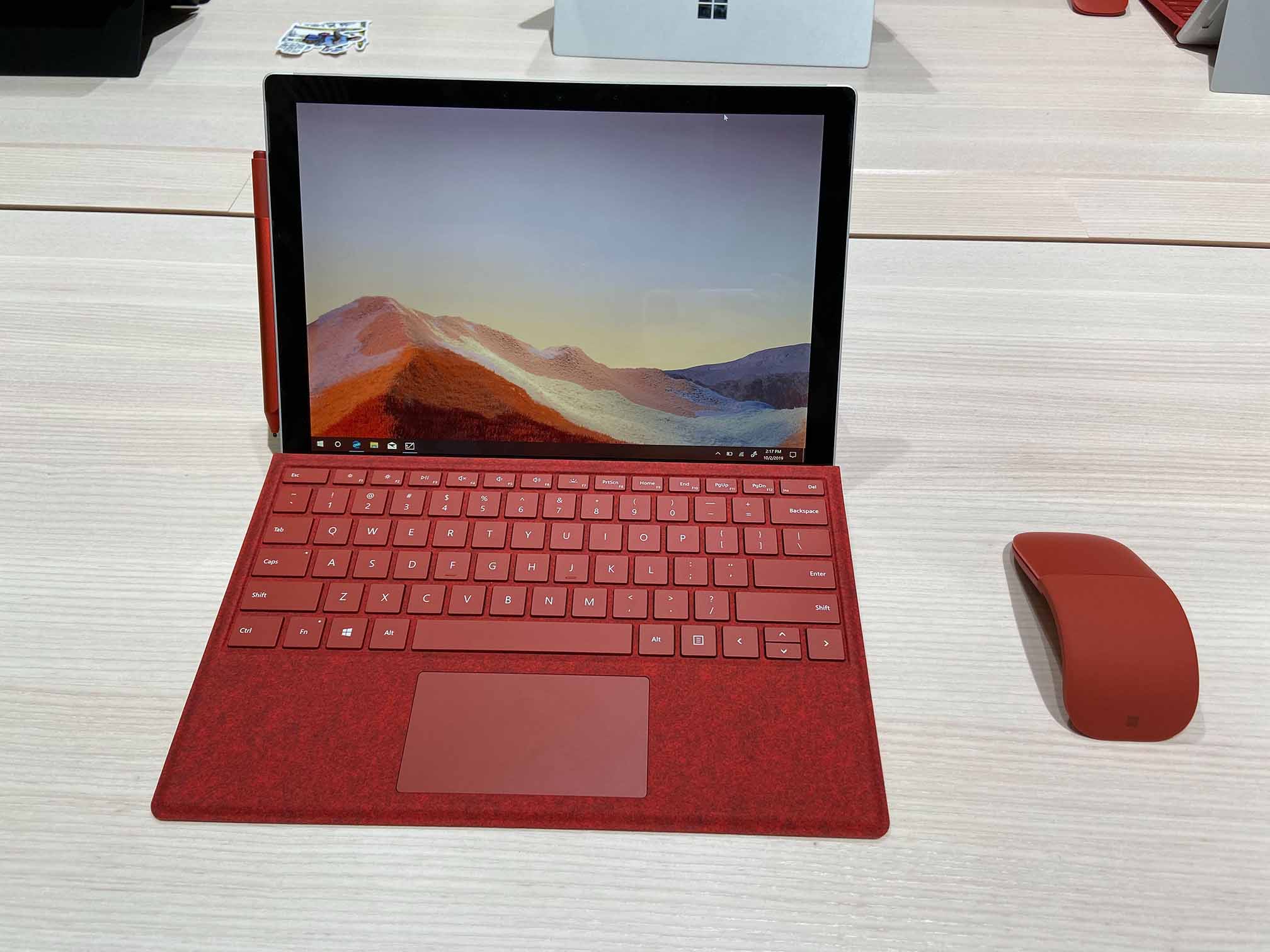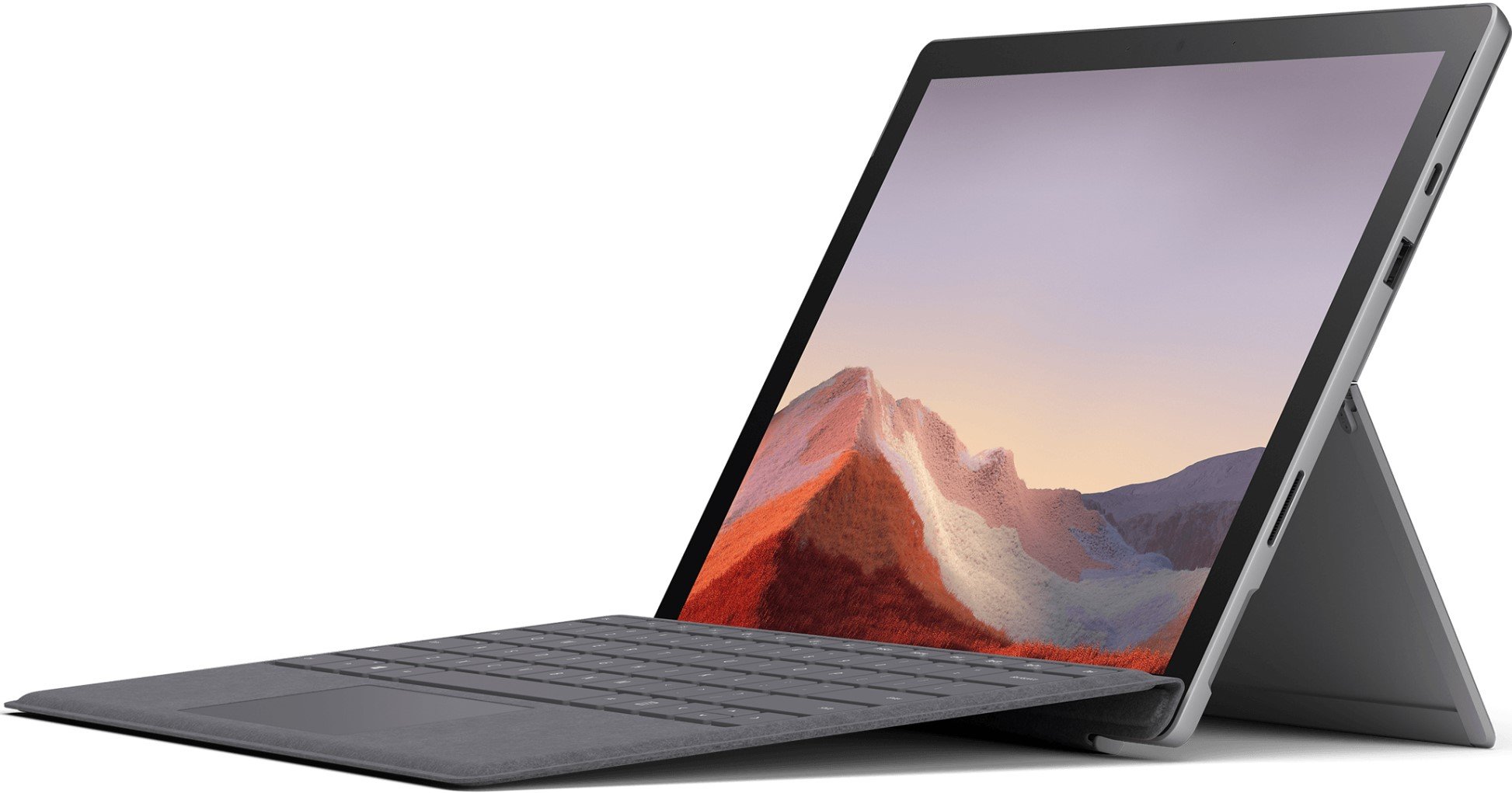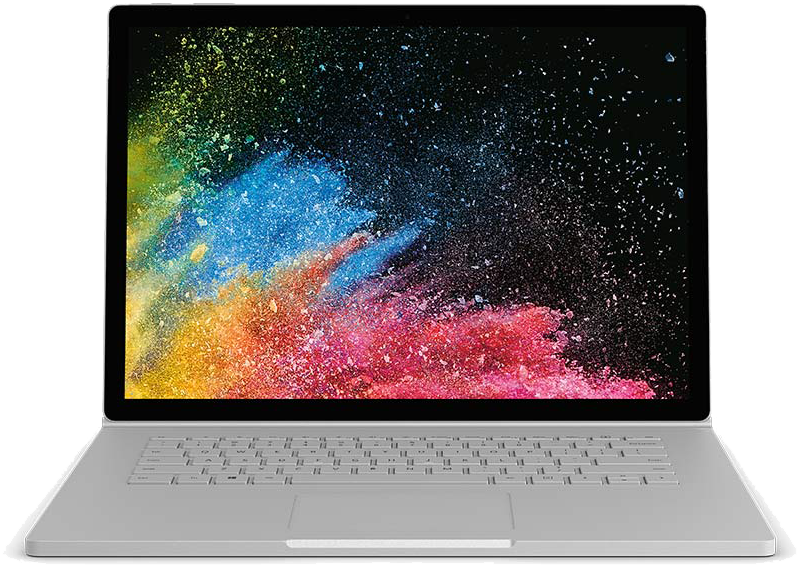

Next in the Pro line
The Surface Pro 7 brings 10th Gen Intel Core "Ice Lake" processor (CPU) options for excellent performance and Wi-Fi 6 compatibility. It now has a USB-C port for better connectivity, and it comes in a couple of colors at a lower starting price. However, there's no dedicated graphics card (GPU) option, battery life won't quite match up, and you'll pay extra for a Type Cover.
For
- 10th Gen Intel Core "Ice Lake" CPUs
- Now includes USB-C port
- Ready for Wi-Fi 6
- Available in Matte Black and Platinum colors
- Lower starting price
Against
- No dedicated GPU options
- Pay extra for Type Cover
- Battery not as large

Powerful modular notebook
The Surface Book 2, available in two sizes, is starting to show its age, but it's still a powerhouse modular notebook. You get a dedicated GPU for specialized work, can use the display portion as a tablet when not connected to the base, and enjoy a better port selection, including full-size SD card reader. It's not as portable, and you don't get Wi-Fi 6 connectivity, but it's a better option for power users.
For
- Dedicated GPU available
- Versatile modular design
- Available in 13.5- and 15-inch models
- Better port selection, including full-size SD reader
- Larger battery for longer life
Against
- Using 8th Gen Intel Core CPUs
- Not as portable
- No Wi-Fi 6 compatibility
The Surface Pro 7 and the Surface Book 2 are both built to a premium standard, but they're made for slightly different use cases. Thanks to the dedicated GPU and larger display options, the Book 2 is better cut out for specialized work or gaming, and the larger batteries (70Wh and 80Wh) will ultimately deliver longer life when going about regular productivity tasks. The Pro 7 is the more portable option, but a lack of dedicated graphics cards might be a deal-breaker for some. Still, it's using 10th Gen Intel Core "Ice Lake" CPUs for impressive performance and Wi-Fi 6 connectivity. Let's take a close look at the specs that make up these two PCs.
Microsoft Surface Pro 7 vs. Surface Book 2: tech specs
| Header Cell - Column 0 | Surface Pro 7 | Surface Book 2 |
|---|---|---|
| OS | Windows 10 | Windows 10 |
| Processor | 10th Gen IntelCore i3-1005G1Core i5-1035G4Core i7-1065G7 | 7th Gen Intel Core i5-7300U8th Gen IntelCore i5-8350UCore i7-8650U |
| RAM | 4GB, 8GB, 16GB LPDDR4x | 8GB, 16GB LPDDR3 |
| Storage | 128GB, 256GB, 512GB, 1TB SSD | 256GB, 512GB, 1TB SSD |
| Display size | 12.3 inchesTouch | 13.5 inches15 inchesTouch |
| Display resolution | 2736x1824267 PPI | 3000x2000 (267 PPI)3240x2160 (260 PPI) |
| Aspect ratio | 3:2 | 3:2 |
| Graphics | Intel UHD (i3)Intel Iris Plus (i5, i7) | Intel HD 620 (i5)NVIDIA GTX 1050 (i7)NVIDIA GTX 1060 (i7) |
| Ports | USB-C 3.1USB-A3.5mm audioSurface ConnectmicroSD card reader | Two USB-A 3.1USB-C 3.13.5mm audioTwo Surface ConnectSD card reader |
| LTE | No | No |
| Camera | Front-facing 5MP (1080p)Rear-facing 8MP (1080p) | Front-facing 5MP (1080p)Rear-facing 8MP (1080p) |
| Biometrics | IR camera | IR camera |
| Battery | Up to 10.5 hours | 70Wh (13.5-inch), 80Wh (15-inch)Up to 17 hours |
| Dimensions | 11.5 x 7.9 x 0.33 inches(292mm x 201mm x 8.5mm) | 13.5-inch Book 212.3 x 9.14 x 0.51 - 0.90 inches (i5)12.3 x 9.14 x 0.59 - 0.90 inches (i7)15-inch Book 213.5 x 9.87 x 0.568 - 0.90 inches |
| Weight | From 1.7 pounds (775g) | 13.5-inch from 3.38 pounds (1.53kg)15-inch from 4.2 pounds (1.9kg) |
Features and design
The Surface Pro 7 hasn't seen much of a physical change compared to the Pro 6, though it does now have a single USB-C 3.1 port instead of Mini DisplayPort. This change adds some versatility to the accessories you can connect, including external monitors. The Pro 7 also has USB-A for your older devices, a 3.5mm audio jack, Surface Connect, and a microSD card reader. The larger Surface Book 2 has more room for ports and makes good on the space with two USB-A 3.1, USB-C, two Surface Connect ports, 3.5mm audio, and a full-size SD card reader.
Whereas the Pro 7 is sold as a tablet to which you can add a Type Cover for a full notebook experience, the Surface Book 2 comes as a complete notebook with a display, keyboard, and touchpad. The display portion contains everything it needs inside to work on its own, and it can be detached from the base. You can use it as a tablet to browse the internet, watch a movie, or sketch with a Surface Pen, then connect it back to the base to take advantage of extra battery and a dedicated GPU for maximum productivity. The tablet can even reattach backward to face out, effectively creating a stand with which you can angle the display.
Both devices utilize an IR camera for secure logins through Windows Hello, and both have similar standard camera hardware for shooting FHD video and stills. The main design decision between these two will come down to whether or not you want a tablet first, notebook second (in the case of the Pro 7), or a notebook first and tablet second (in the case of the Book 2). Keep in mind that the Pro 7 will prove to be more portable than even the 13.5-inch Book 2, making it an excellent choice for those always on the move.
Display and inking
The Surface Book 2 comes in both 13.5-inch and 15-inch display options. The smaller display has the same 267 pixels-per-inch (PPI) as the 12.3-inch Pro 7 display, while the larger Book 2 display sits at 260 PPI. The Book 2's resolution indeed appears higher in the stat sheet due to the larger physical size, but know that you're going to get a knockout touch display no matter which device you end up taking home.
The Pro 7 and both models of the Book 2 have a 3:2 aspect ratio for a boxy look with lots of real estate, and all displays are compatible with a Surface Pen for a natural inking feel. You get 4,096 levels of pressure sensitivity and tilt support, and it can be combined with a Surface Dial for improved handling and productivity. Note that only with the Book 2 can you use the Surface Dial directly on the display, while the Pro 7 is compatible with off-screen interactions only.
Performance and price
The Surface Book 2, along with two available sizes, can be had in a wide variety of configurations. The 13.5-inch model is still available with a 7th Gen Intel CPU, but there are also 8th Gen i5 and i7 options available for improved performance. These are 8th Gen "Kaby Lake R" chips, so do not benefit from the performance boost we saw with the later "Whiskey Lake" CPUs, but they're still able performers. The smaller Book 2 has an NVIDIA GTX 1050 dedicated GPU available if you opt for the Core i7 CPU, and you can get up to 16GB of LPDDR3 RAM and 1TB PCIe SSD.
Get the Windows Central Newsletter
All the latest news, reviews, and guides for Windows and Xbox diehards.
The 15-inch Book 2 has available 8th Gen Core i5 and Core i7 CPUs, and it can be had with an NVIDIA GTX 1060 dedicated GPU with 6GB of VRAM if you opt for the speedier CPU. It can also be configured with up to 16GB of RAM and a 1TB SSD. Prices for the 13.5-inch Book 2 start at about $999, while the larger model starts at about $1,699.
The Surface Book 2 models have larger batteries than available in the Pro 7, and you should be able to push a full workday if you're just going about standard productivity work. However, if you're often using a dedicated GPU, battery life will no doubt fall below what's available in the Pro. Note that the tablet portion of the Book 2, when detached, doesn't have access to the full battery, so you won't get nearly as much life as in the Pro 7, which has all hardware contained within the tablet. On that note, the dedicated GPUs are also included in the base of the Book 2, so using it as a tablet without the keyboard attached will leave you with only integrated Intel graphics.
The main update to the Pro 7 is 10th Gen Intel "Ice Lake" CPUs. You can get Core i3, Core i5, and Core i7 chips depending on how much performance you need, and you'll enjoy relatively powerful integrated Iris Plus graphics from the Core i5 and Core i7. It won't match dedicated GPU power, especially the NVIDIA GTX 1060, but you'll still be able to enjoy some light and medium gaming. We will have to wait to test on our own, but Microsoft is claiming about 10.5 hours of battery life from a charge.
Along with improved raw CPU performance compared to 8th Gen Intel chips, you have a device that's ready for Wi-Fi 6 connectivity, whereas the Book 2 is stuck on the familiar Wi-Fi 5. If you value blazing wireless speeds, the Pro 7 is undoubtedly the better choice, though you'll likely need to invest in a new router.
Surface Pro 7 models start at a lower $749 price, though baseline configurations have inside a Core i3 CPU, 4GB of RAM and a 128GB SSD. You also have to keep in mind that Type Covers are sold separately; adding a Signature Type Cover to your Pro 7 can tack on up to about $160 to the total price.
Stick the with Surface Pro 7 for a more portable, versatile PC
The Pro 7 doesn't have a dedicated GPU option, but 10th Gen Intel Core CPUs will offer more raw performance than 8th Gen CPUs in the Book 2. You also get Wi-Fi 6 connectivity for blazing wireless speeds, as well as a USB-C port for improved connectivity. If you value mobility and prefer a tablet first, notebook second type experience, the Pro 7 should be your first choice.

10th Gen Intel CPUs and Wi-Fi 6
The Surface Pro 7 has been refreshed with new CPUs and a USB-C port. It's an ideal device if you want to stay mobile yet have the performance to crush a day's work.
The Surface Book 2 is a powerhouse for power users
With dedicated GPU and up to a 15-inch size, the Book 2 is better cut out for power users. The 8th Gen Intel Core CPUs are starting to show their age, especially in the face of 10th Gen chips, but they will still perform. You'll get longer battery life as long as you're not pushing the GPU, and you can remove the display from the keyboard and touchpad base when you just need a tablet. If you like the idea of a powerful notebook first, tablet second, the Book 2 should make a great choice.

Dedicated GPU, two sizes to choose from
You get more rounded performance from the Book 2 thanks to a dedicated GPU, and it's available with a larger 15-inch display. It's the right pick for power users, especially if you're interested in a better gaming experience.

Cale Hunt brings to Windows Central more than eight years of experience writing about laptops, PCs, accessories, games, and beyond. If it runs Windows or in some way complements the hardware, there’s a good chance he knows about it, has written about it, or is already busy testing it.
